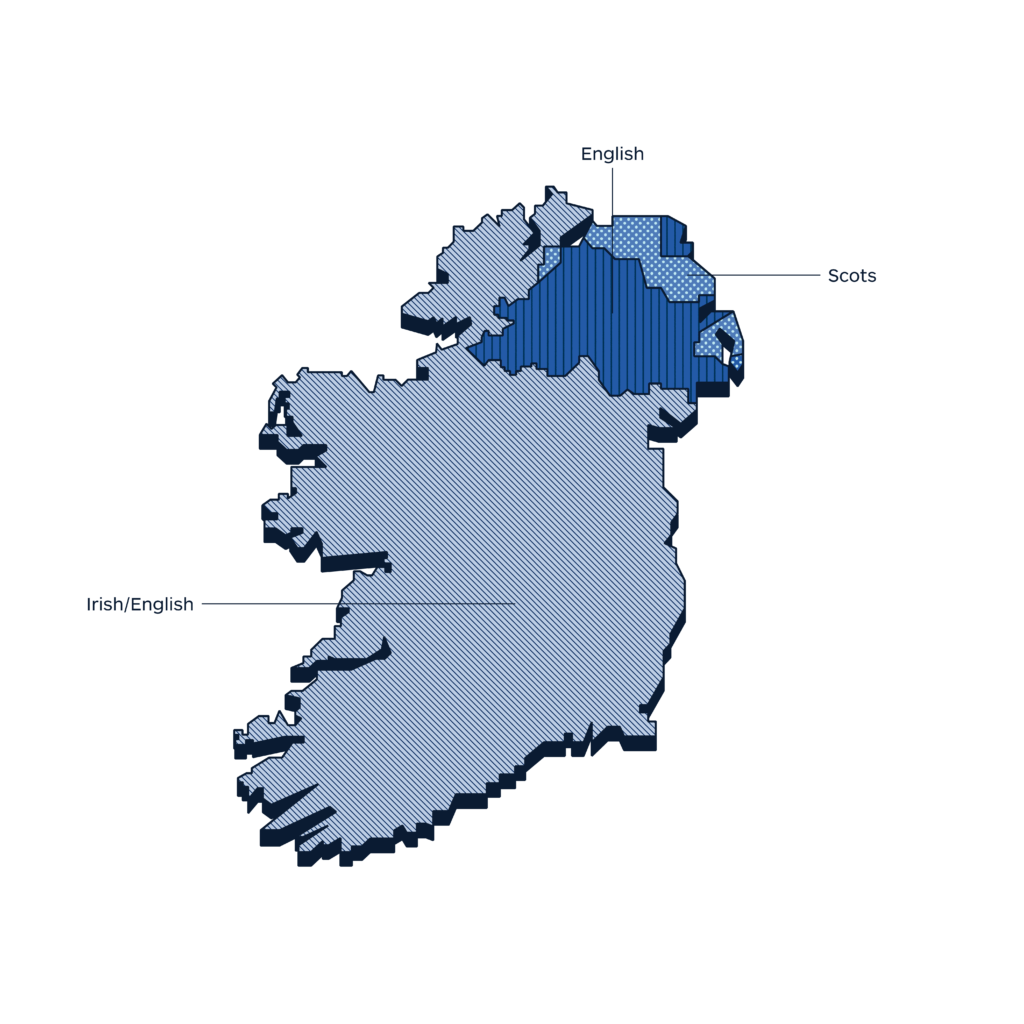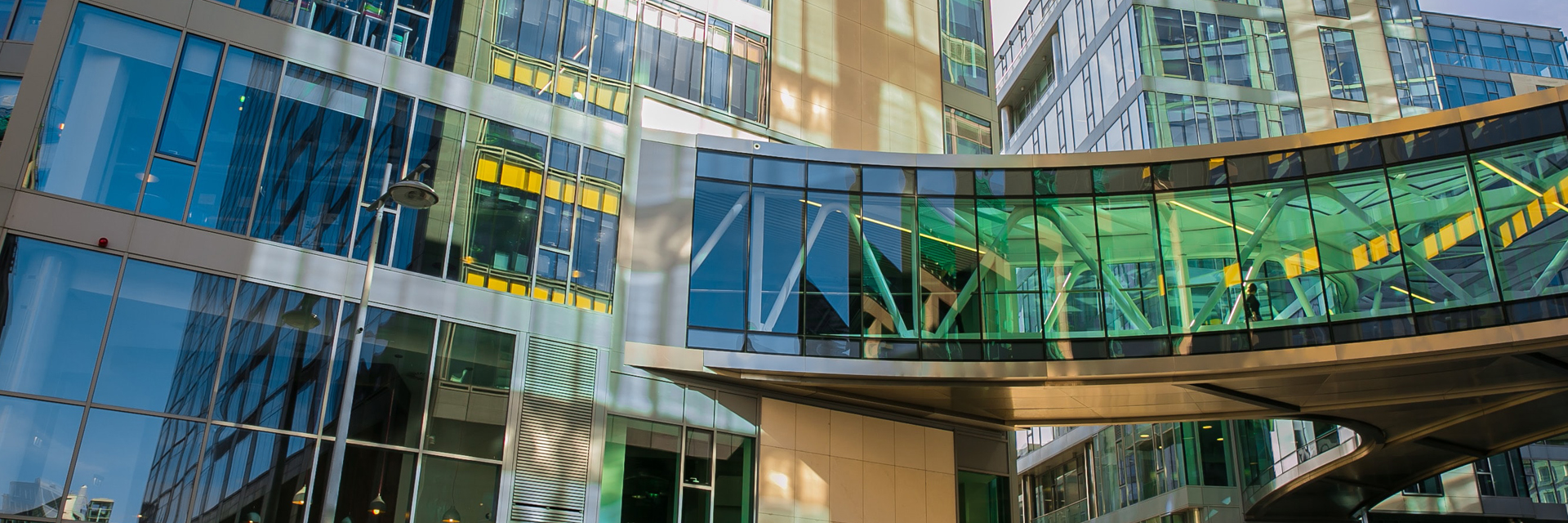Europe
To which language should you translate to localize in Ireland?
What we know from our community
The main language spoken in Ireland is English, differing dialects and accents add colour and flavour to the language. But the culture of language has an old history in the Emerald Isle. Before the introduction of English, Irish Gaelic would have been the dominant language. There are enclaves of Donegal, Kerry and Galway where this still is the majority language spoken. Even within the Irish Gaelic language there are dialects, which developed due to slight differences in accent and expression.
LANGUAGE INSIGHT
Official language
English (98.4%; 5.17 mln), Gaelic (1.6%; 84k)
What the top 150 best localized websites in the world do in Ireland
(Top 150 websites listed in the Global by Design ranking – published annually by Byte Level Research, this report provides a list of globally localized websites, showcasing best practices and emerging trends in their globalization)
- 126/150 localize by translating into English
- 4/150 localize by translating into both English and Gaelic
- 1/150 localizes by translating into English, Gaelic and Irish Sign Language
- 1/150 localizes by translating into English, French and Simplified Chinese
- 1/150 localizes by translating into English, German and French
- 1/150 localizes by translating into English, Spanish, Italian, German, French, Portuguese, Simplified Chinese, Russian, Polish, Korean and Japanese
- 1/150 localizes by translating into English, Spanish, Italian, German, French, Portuguese, Simplified Chinese, Traditional Chinese, Russian, Korean and Japanese
- 1/150 localizes by translating into English, Spanish, Italian, German, French and Simplified Chinese
- 1/150 localizes by translating into English, Spanish, Italian, German, French, Portuguese, Simplified Chinese, Traditional Chinese, Russian, Polish, Japanese, Bahasa Indonesia, Hungarian, Romanian, Turkish, Thai and Ukrainian
-
3M
-
ABB
-
Accenture
-
Adidas
-
Adobe
-
Airbnb
-
Aldi
-
Amazon
-
American Airlines
-
American Express
-
Apple
-
Audi
-
Autodesk
-
Avis
-
Bayer
-
BMW
-
Booking.com
-
Bosch
-
British Airways
-
Bumble
-
Burberry
-
BYD
-
Canon
-
Capgemini
-
Cartier
-
Caterpillar
-
Chevrolet
-
Cisco Systems
-
Citibank
-
Coca-Cola
-
Costco
-
Dell
-
Deloitte
-
Delta
-
DHL
-
Disney+
-
Dyson
-
eBay
-
Eli Lilly
-
Emirates
-
Ernst & Young
-
Facebook
-
FedEx
-
Ford
-
Four Seasons
-
Fujifilm
-
GE
-
Gillette
-
GoDaddy
-
Google
-
Gucci
-
Haier
-
Heineken
-
Hermès
-
Hertz
-
Hilton
-
Hisense
-
Hitachi
-
Honda
-
Hotels.com
-
HP
-
HP Enterprise
-
HSBC
-
Huawei
-
Hyatt
-
Hyundai
-
IBM
-
IKEA
-
Intel
-
InterContinental Hotels
-
J&J
-
Jack Daniel's
-
Jehovah’s Witnesses
-
John Deere
-
Kellogg's
-
Kia
-
KPMG
-
L'Oréal
-
Land Rover
-
LEGO
-
Lenovo
-
Lexus
-
LG
-
Louis Vuitton
-
Lululemon
-
LUSH
-
Marriott
-
MasterCard
-
McDonald's
-
Mercedes-Benz
-
Merck
-
Microsoft
-
Mitsubishi Electric
-
Nestlé
-
Netflix
-
Nike
-
Nikon
-
Nintendo
-
Nio
-
Nissan
-
NIVEA
-
Oracle
-
Pampers
-
Panasonic
-
PayPal
-
Pepsi
-
Pfizer
-
Philips
-
Pitney Bowes
-
Porsche
-
Procter & Gamble
-
PWC
-
Revolut
-
Rolex
-
Royal Caribbean
-
Salesforce
-
Samsung
-
Sanofi
-
SAP
-
Sephora
-
Shopify
-
Siemens
-
Sony
-
Spotify
-
Starbucks
-
Steelcase
-
Stripe
-
Subaru
-
Tesla
-
The Church of Jesus Christ of Latter-day Saints
-
Tiffany
-
Tinder
-
Toshiba
-
Toyota
-
TripAdvisor
-
Uber
-
United Airlines
-
UPS
-
Visa
-
Volkswagen
-
Volvo Cars
-
Vrbo
-
Walmart
-
Western Union
-
Wikipedia
-
Wise
-
WordPress
-
Workday
-
Xerox
-
Xiaomi (Mi)
-
Zara
-
Zoom
If you need others information, below you can find a selection of economic/social/cultural data
Overview
Language
Official language
English (98.4%), Gaelic (1.6%)
T-index
0.24%
T-Index ranks countries according to their potential for online sales.
Most studied languages
French (spoken by 20% of the population), German (7%) and Spanish (3.7%).
Demography
Capital: Dublin
Currency: Euro
Population: 5,127 milion
Population density: 73/km2
Economy
GDP: 533.14 billion USD (2022)
GDP per capita: 103,983.3 USD (2022)
Exports: $236 billion (2022)
Statistics
Internet users: 99% penetration, 5.02 million
Unemployment rate: 4.3% (2023)
Urbanisation: 64.6% (2024)
Literacy: 99% (2024)
Conventions
Numbering system
Arabic numerals and dot as decimal separator
Date format: dd-mm-yyyy
Time: 24h time system
Country code: 00353
Language data sources: Worldatlas/Britannica//EF/Wikipedia; Demography data sources: IMF/Worldometers; Conventions data source: Wikipedia; Economy data sources: WTO/OEC/CIA/Esomar/Datareportal; Statistics data sources: Datareportal/WorldBank/UN/UNESCO/CEIC/IMF/Culturalatlas/Commisceoglobal
Facts and data
Economy
Imports
$127 billion (2022). Planes, Helicopters, and/or Spacecraft ($8.23B), Nitrogen Heterocyclic Compounds ($8.17B), Refined Petroleum ($5.6B), Petroleum Gas ($5.04B), and Vaccines, blood, antisera, toxins and cultures ($5.04B), importing mostly from United Kingdom ($32.6B), United States ($20.5B), Germany ($11.1B), China ($8.11B), and Netherlands ($7.03B).
Financial inclusion factors (over 15 years of age)
• 95% have an account with a financial institution
• 51% have a credit card
• 69% make online purchases
Ease of doing business
It is very easy to conduct business (rated 79.6 out of 100) ranked 15th out of 34 European countries ranked 24th out of 190 countries worldwide (2019, World Bank).
Global Innovation Index
Ranked 14th out of 39 European countries, 22nd out of 132 worldwide.
The Global Innovation Index captures the innovation
ecosystem performance of 132 economies and tracks the most recent global innovation trends.
Exports
$236 billion (2022). Vaccines, blood, antisera, toxins and cultures ($47.3B), Packaged Medicaments ($34.8B), Nitrogen Heterocyclic Compounds ($24.4B), Integrated Circuits ($15.4B), and Scented Mixtures ($10.4B), exporting mostly to United States ($70.7B), Germany ($28.6B), United Kingdom ($19B), Belgium ($17B), and China($16.7B).
Main local online stores
Amazon, Netflix and Aib.ie. Other top retail sites include IrishTimes.com, LinkedIn.com, IMDB.com, eBay, 365online.com, paypal.com and eir.ie.
Economic freedom
‘Free’ (rated 82.6 out of 100) ranked 2nd out of 44 European countries ranked 3rd out of 186 countries worldwide (2024, Heritage Foundation and Wall Street Journal).
Economy data sources: WTO/OEC/CIA/Esomar/Datareportal
Service Imports (2020)
Service Exports (2020)
Source: OEC
Trade balance of goods from 2012 to 2022
Source: Statista
Historical Data Trade Imports (2020)
The following section uses historical trade data imports from partners of Ireland.
Historical Data Trade Exports
The following section uses historical trade data exports from partners of Ireland.
Source: OEC
The Top Export Opportunities for Ireland by Relatedness
Relatedness measures the distance between a country's current exports and each product by showing only products that Ireland is not specialized in.
Brazil's Most Complex Exports
The Product Complexity Index (PCI) measures the knowledge intensity of a product by considering the knowledge intensity of its exporters.
Source: OEC
Ireland's Most Specialized Products
Specialization is measured using Revealed Comparative Advantage (RCA), an index that takes the ratio between Ireland observed and expected exports in each product.
Source: OEC
Perception of products made in selected countries in 2017
Source: Statista
Which attributes do you associate with products made in Ireland?
Source: Statista
Market Growth Imports (2020)
This score represents the likelihood that the given country will start importing that product in the next few years. It forecasts the opening of a new specific market.
Market Growth Exports (2020)
This score represents the likelihood that the given country will start exporting that product in the next few years. It forecasts the opening of a new specific market.
Source: OEC
Foreign direct investment, net inflows (% of GDP)
Source: WorldBank
Preferred e-commerce method
Source: J.P. Morgan 2019 Payment Trends

T-index
Reach most of the online purchasing power
T-Index ranks countries according to their potential for online sales. It estimates the market share of each country in relation to global e-commerce.
Try it nowMedia
Media language
Irish, English
Information channels:
Public broadcaster Raidió Teilifís Éireann (RTE) provides TV, radio and online services in English and Irish. It is funded by a TV licence fee and advertising. Virgin Media One, formerly TV3, is the main national commercial TV station. British public and commercial networks are widely available. Ireland’s free-to-air digital terrestrial TV platform is Saorview and Sky Ireland is the main satellite pay TV provider. The constitution guarantees media freedom and print and broadcast outlets operate freely within the confines of the law. Broadcasting – commercial and public – is regulated by the Broadcasting Authority of Ireland. Reporters Without Borders (RSF) has raised concerns about the high concentration of media ownership. It says much of the newspaper sector is run by Independent News and Media (INM), while RTE dominates the broadcasting scene. There were 4.8 million internet users by December 2017, comprising nearly 93% of the population (Internetworldstats.com). Facebook is the leading social network.
Television
RTE – public, operates RTE 1, RTE 2, RTE News Now, RTEjr
TG4 – public, Irish-language
Virgin Media One – national, commercial
The press
The Irish Times – national daily
Irish Independent – national daily
Irish Examiner – Cork-based national daily
Sunday World, external – popular weekly
Business Post, external – weekly
The following Irish editions of British papers are also published:
The Times and the Sunday Times, external
The Irish Sun, external and its Sunday edition
The Irish Daily Star
The Irish Mirror, external and its Sunday edition
The Irish Daily Mail, external and the Irish Mail on Sunday
Radio
RTE – public, operates flagship station Radio 1, pop music station 2 FM, Irish-language Raidio na Gaeltachta, classical and cultural station Lyric FM and digital-only services
Today FM – national, commercial
Newstalk – national, commercial
Media data source: BBC

The “back to Irish” trend is uniting Ireland and Northern Ireland
By Emma Gamba
A new trend is emerging: Irish is no longer considered unfashionable or useless, and more and more people want to learn the language. There is evidence that in 2021, according to new data released by the language app Duolingo, Irish is the fastest growing language, with over 1 million people actively learning Irish every week on it. It is also the number one language being learned in Ireland.
The "back to Irish" trend is uniting Ireland and Northern irelandInternet Data
Internet users
99% penetration, 5.02 million.
Share of web traffic by device
61.90% mobile phones, 35.38% computers (laptops and desktops), 2.62% tablet devices, others 0.10%.
Median speed of mobile Internet connection
33.09 Mbps
Median speed of fixed Internet connection
102.55 Mbps
Mobile connection as a percentage of total population: 106%
Percentage of mobile connections that are broadband (3G-5G): 97%
Most popular web search engines
Google (95.62%), Bing (2.85%), Yahoo (0.73%), Duckduckgo (0.46%), Ecosia (0.2%), Yandex Ru (0.1%).
Most used social media
Facebook (76.73%), Instagram (9.96%), Twitter (6.47%), Pinterest (2.35%), YouTube (2.18%), reddit (1.6%).
Internet data sources: Datareportal/Statcounter
Social statistics
Life expectancy
83 yrs (2022)
Average age of the population
38.2 yrs (2020)
Healthcare Expenditure
6.07% (2022)
Education Expenditure
92.9% (2020)
Glass Ceiling Index
55.7 out 100, ranked 21st out of 29 countries.
The glass-ceiling index measures the environment for working women combining data on higher education, labor-force participation, pay, child-care costs, maternity and paternity rights, business-school applications, and representation in senior jobs.
Co2 emissions
6.8 metric tons per capita (2020)
Class
Social privilege in Ireland, in any case, is often dictated more by knowing in which circles one should curry favour. In Dublin, many would say that you could tell a person’s class by their postal code – the Dublin 4 or “D4” area being a prime example of neighbourhoods universally considered to be well heeled.
Ethnicity
Many people consider the Travelling People in Ireland as a distinct ethnic group. Travellers have often experienced systemic discrimination, poverty and exclusion. Travelling People have a distinct dialect and follow a nomadic way of life. Since the advances in the Irish economy, Ireland has also become a magnet for immigrant workers from Eastern Europe and Africa. To facilitate the growing diversity of Ireland, in October 2005, the Government introduced the National Action Plan Against Racism, one of the most comprehensive anti-discrimination codes in Europe.
World Happiness Index
Ireland ranked 13 out of 146 countries, with a score of 7.041.
Corruption perceptions Index
Ireland scored 77 out of 100, ranked 10 out 180 countries worldwide.
Religion
Catholicism has been a key factor in shaping Irish society and culture. In recent years, however, the influence of the Catholic Church has begun to wane and social values are beginning to converge with those of other European countries, particularly within the younger, urban and more educated population. Church scandals have contributed to this trend. Weekly Mass attendance still hovers around 60%, compared with the European average of 30%; many children also attend Catholic schools. There have been campaigns in recent years, however, to end the broadcast of the Angelus, a Catholic devotion, on RTE (the public broadcaster).
Gender
As a society heavily influenced by Catholicism, the traditional role of mother and wife has dominated beliefs about women in Irish culture and has been enshrined in the country’s Constitution. Up until Ireland’s accession to the European Community in 1973, women were obliged to resign from civil service positions upon marriage. Since then, better education, declining fertility rates and an opportunity to earn higher wages have increased women’s participation in the labour force. Married women, however, have a considerably lower participation rate compared to other European countries; the lack of childcare and discriminatory tax policies are key factors. Occupational segregation is still very marked, and women are frequently found in low-paid, part-time, insecure and “low-skilled” occupations, with very few in senior management. The situation is changing, however, with the election of two women to the role of President within the last fifteen years. Compliance to European Union equal opportunity legislation has also promoted the status of women.
Social statistics sources: WorldBank/UN/UNESCO/CEIC/IMF
The Data Factbook is a work in progress project. Our community is helping us to fill it up always with new and updated data. Your contribution is precious. If you want to help us, please write your advices at imminent@translated.com
Languages research
Languages spoken in Ireland

Legend
-
English
-
Scots
-
Irish/English
The language research that you will find in the maps published in this section is a work in progress. Our community is helping us to fill it up with always new and updated data. Your contribution is precious. If you want to help us, please write to imminent.factbook@translated.com
Photo credit: Stephen Bergin, Unsplash


